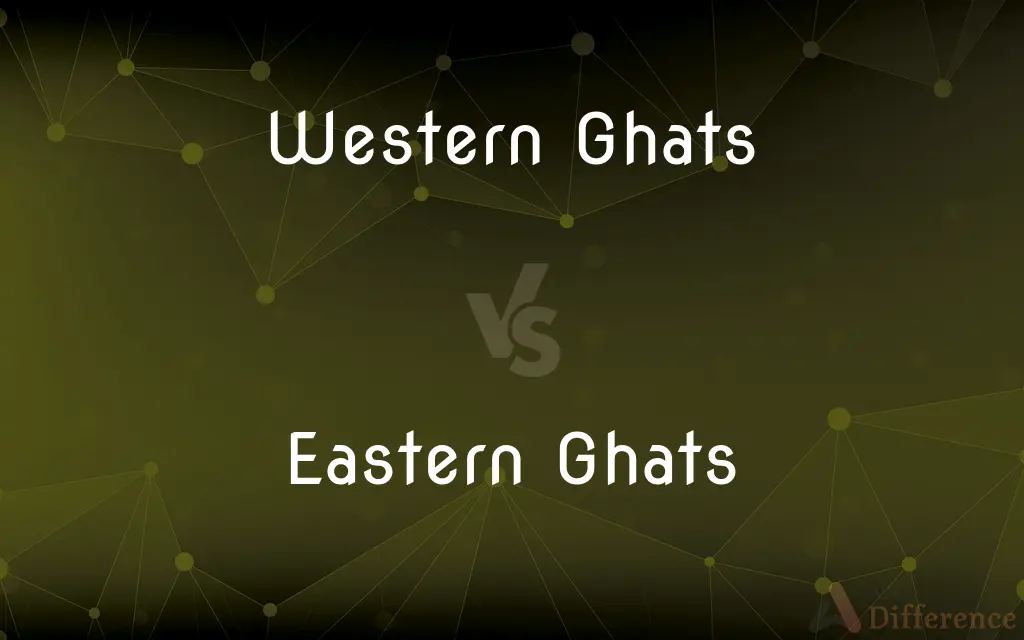Western Ghats vs. Eastern Ghats — What's the Difference?
By Tayyaba Rehman — Published on January 22, 2024
Western Ghats is a mountain range running parallel to India's western coast, known for biodiversity. Eastern Ghats is a discontinuous range of hills along India's eastern coast, less dense and ecologically diverse.

Difference Between Western Ghats and Eastern Ghats
Table of Contents
ADVERTISEMENT
Key Differences
The Western Ghats, extending along the western coast of India, are known for their rich biodiversity and are a UNESCO World Heritage site. In contrast, the Eastern Ghats, running along the eastern coast, are more fragmented and less continuous, with a different ecological profile.
In terms of ecological significance, the Western Ghats host a larger number of endemic species and more dense forests. The Eastern Ghats, while also rich in biodiversity, are less dense and have a more varied topography with mixed forest types.
The Western Ghats have a higher average elevation, with peaks like Anamudi and Meesapulimala, compared to the relatively lower peaks of the Eastern Ghats, like Arma Konda. This difference in elevation contributes to distinct climatic conditions in each range.
The Western Ghats play a crucial role in affecting the monsoon weather patterns in India, receiving heavy rainfall, which makes them vital for peninsular India's water security. The Eastern Ghats, receiving less rainfall, have a different impact on local weather.
Culturally and historically, both the Western and Eastern Ghats have been significant. The Western Ghats have ancient hill stations and religious sites, while the Eastern Ghats are known for their rich cultural heritage and historical temples.
ADVERTISEMENT
Comparison Chart
Biodiversity
Richer biodiversity, more endemic species.
Less dense, mixed biodiversity.
Topography
More continuous, higher elevation.
More fragmented, varied topography.
Climatic Impact
Affect monsoon patterns, receive heavy rainfall.
Receive less rainfall, different climate impact.
Ecological Significance
More dense forests, important for water security.
Less dense, varied forest types.
Cultural Significance
Ancient hill stations, religious sites.
Known for rich cultural heritage and temples.
Compare with Definitions
Western Ghats
Characterized by dense forests and high biodiversity.
The dense forests of the Western Ghats are crucial for India's ecology.
Eastern Ghats
Rich in cultural heritage and historical significance.
Many ancient temples in the Eastern Ghats are of historical importance.
Western Ghats
Influences the monsoon weather patterns in India.
The Western Ghats play a key role in bringing monsoon rains to the region.
Eastern Ghats
Receives less rainfall and has different climatic impacts.
The Eastern Ghats experience a different climate compared to the Western Ghats.
Western Ghats
A mountain range along India's western coast.
The Western Ghats are known for their stunning natural beauty.
Eastern Ghats
A range of hills along India's eastern coast.
The Eastern Ghats are known for their scenic beauty and hills.
Western Ghats
Home to diverse flora and fauna.
Many unique species are found only in the Western Ghats.
Eastern Ghats
Has a varied topography with discontinuous hills.
The hills of the Eastern Ghats are not as continuous as the Western Ghats.
Western Ghats
Contains several important hill stations and religious sites.
Hill stations in the Western Ghats are popular tourist destinations.
Eastern Ghats
Features a mix of forest types and biodiversity.
The Eastern Ghats have a diverse range of flora and fauna.
Common Curiosities
What is the main feature of the Eastern Ghats?
They are characterized by discontinuous hills and mixed forest types.
Where are the Western Ghats located?
Along the western coast of India.
What is the highest peak in the Eastern Ghats?
Arma Konda is one of the highest peaks in the Eastern Ghats.
Do the Western Ghats receive more rainfall?
Yes, they receive heavy monsoon rainfall.
How do the Western Ghats affect India's weather?
They significantly influence the monsoon weather patterns in India.
Is trekking popular in the Western Ghats?
Yes, trekking is a popular activity due to the scenic beauty and challenging terrain of the Western Ghats.
Are the Western Ghats a UNESCO World Heritage Site?
Yes, due to their rich biodiversity.
Are the Eastern Ghats culturally significant?
Yes, they are known for their rich cultural heritage and historical temples.
Which Ghats are more continuous in topography?
The Western Ghats are more continuous compared to the Eastern Ghats.
What type of biodiversity can be found in the Western Ghats?
The Western Ghats have a diverse range of endemic flora and fauna.
What kind of forests can be found in the Eastern Ghats?
The Eastern Ghats have a mix of deciduous, semi-evergreen, and dry evergreen forests.
Can the Western Ghats be seen as a biodiversity hotspot?
Absolutely, they are considered one of the world's eight 'hottest hotspots' of biological diversity.
What is the role of the Eastern Ghats in Indian ecology?
They play a crucial role in maintaining the ecological balance of the eastern part of India.
Do both Ghats have ecological importance?
Yes, both play important roles in their respective ecological systems.
Are the Eastern Ghats important for biodiversity conservation?
Yes, despite being less dense, they are significant for biodiversity conservation.
Share Your Discovery

Previous Comparison
UGC vs. AICTE
Next Comparison
Hallucinations vs. IllusionsAuthor Spotlight
Written by
Tayyaba RehmanTayyaba Rehman is a distinguished writer, currently serving as a primary contributor to askdifference.com. As a researcher in semantics and etymology, Tayyaba's passion for the complexity of languages and their distinctions has found a perfect home on the platform. Tayyaba delves into the intricacies of language, distinguishing between commonly confused words and phrases, thereby providing clarity for readers worldwide.














































